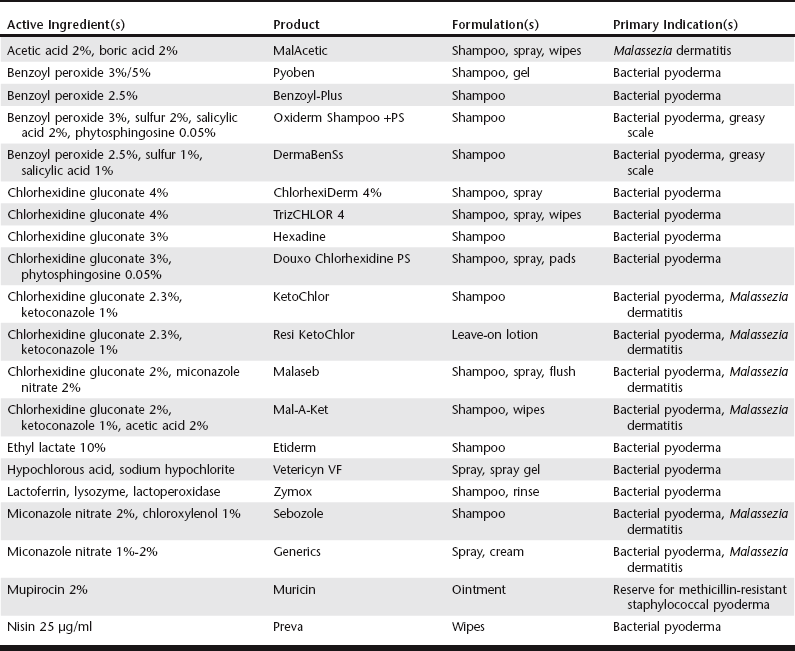Chapter 102 • Demonstration and written instructions should be provided to clients on the proper use of prescribed topical products: the reason to use them, the way to use them, the desired response, the duration of treatment, and the need for a recheck to follow progress. • A gentle, general cleansing shampoo should be used before an antimicrobial shampoo to clean the skin and hair coat and minimize the amount of the more expensive medicated product. • The hair coat should be kept short for easier and more successful management of recurrent infections. • The client should be instructed to ensure at least 10 minutes of contact time with gentle lathering for antimicrobial shampoos. • Tepid or cool water should be used and the animal should be rinsed very well, especially when skin is inflamed and pruritic. • The animal should be bathed at least twice weekly to treat a cutaneous infection and then as needed for maintenance. • Antimicrobial sprays, rinses, or wipes should be used between shampoos for continual and residual activity. • Cytologic examination is extremely important before, during, and after treatment to gauge response. The most common organism isolated from pyoderma lesions in dogs is Staphylococcus pseudintermedius (see Chapter 100). Several topical antiseptics and antibiotics are used to treat staphylococcal infections, including benzoyl peroxide, chlorhexidine, miconazole, ethyl lactate, and mupirocin, either alone or in combination. New products and technologies are needed to address emerging bacterial resistance in a safe and effective manner. Benzoyl peroxide is metabolized in the skin to benzoic acid, which alters pH and acts as an oxidizing agent to damage bacterial cell membranes. It is clinically effective in staphylococcal pyoderma, has demonstrated superior prophylactic activity compared with complexed iodine and triclosan, and is used in shampoos and a gel (Table 102-1). Benzoyl peroxide has been formulated with sulfur and salicylic acid for enhanced keratolytic, degreasing, and antibacterial activity. Dermatologists typically use 3% or 4% chlorhexidine shampoos (see Table 102-1). A recent clinical study documented better efficacy of a 3% chlorhexidine gluconate shampoo than of a 2.5% benzoyl peroxide shampoo used as sole therapy for canine superficial pyoderma (Loeffler et al, 2011). A Japanese study (Murayama et al, 2010) revealed comparable clinical activity for a 2% chlorhexidine acetate surgical scrub and a 4% chlorhexidine gluconate shampoo in 10 dogs with superficial pyoderma when treated twice per week. Additionally, in a population of seven dogs with methicillin-resistant staphylococcal (MRS) pyoderma treated with the 2% scrub every 2 days for 2 weeks, five dogs responded completely and one partially. Clinical efficacy may be more contingent on frequency of treatment than concentration of the active ingredient. For more residual activity, a chlorhexidine leave-on conditioner/rinse, spray, or wipe should be used between shampoos (see Table 102-1).
Topical Therapy for Infectious Diseases
Basic Guidelines for Topical Antimicrobials
Bacterial Pyoderma
Benzoyl Peroxide
Chlorhexidine
![]()
Stay updated, free articles. Join our Telegram channel

Full access? Get Clinical Tree



